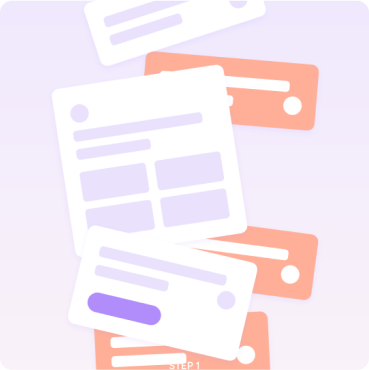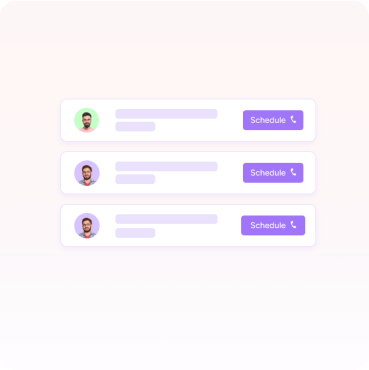Regular hiring
High RiskHire Fullstack Developer of Silicon Valley caliber
Hire pre-vetted full time remote Fullstack Developer from India. Hire now and build your dream engineering team with Hyno
Join 4,000+ companies already growing








Our Top Remote Developers
Hyno conducts rigorous testing and carefully vets the developers who are fueled by passion and skill sets. Hence, our developer community is the foundation for innovation and collaboration, bringing ideas and projects to fruition.
OUR STANDARDS
Hyno vs. Your regular recruitment process.
Find a risk-free, pre-interviewed, high-quality developer who is remote-ready in less than 2 weeks at 40% less cost.
Parameters
Choose the right for your firm.Time
Fees
Quality
Pre Screening
Remote readiness check
Termination
Failure rate
1 - 4 Months
> $1000
High
Low
Freelancing
High Risk1 - 2 Months
No fee
No
Very high
 Low Risk
Low Risk
0 - 15 Days
No fee
No
Very low
Pricing Starts from $35/hr
Accomplishing everything in just 3 steps
Our technical manager aligns the required skillset and tech stack with our talent pool to help you find the best fit.

Shortlisting candidates
Precise Hiring: Understanding, Gathering, and Shortlisting nittygritty.
-
 We start by thoroughly understanding your unique needs and specifications.
We start by thoroughly understanding your unique needs and specifications.
-
 check markWe
align the developer details with company goals. This way, we tailor the candidate
selection to seamlessly integrate with the organization’s vision and goals.
check markWe
align the developer details with company goals. This way, we tailor the candidate
selection to seamlessly integrate with the organization’s vision and goals.


Scheduling an Interview
Effortless talent selection: Finding your perfect match
-
 We connect you with the chosen candidates to ensure a personalized experience.
We connect you with the chosen candidates to ensure a personalized experience.
-
 Our rigorous
selection process guarantees that you find candidates who align seamlessly with your
requirements.
Our rigorous
selection process guarantees that you find candidates who align seamlessly with your
requirements.


Onboarding the talent
Streamlined onboarding for peak performance.
-
 The selected/qualified talent integrates smoothly through structured onboarding to
quickly adapt to projects, processes, and team dynamics.
The selected/qualified talent integrates smoothly through structured onboarding to
quickly adapt to projects, processes, and team dynamics.
-
 We go beyond
integration to offer ongoing support for a seamless transition to ensure that the
new talent exceeds your expectations.
We go beyond
integration to offer ongoing support for a seamless transition to ensure that the
new talent exceeds your expectations.


Read hiring guide
A one-stop shop to hiring the right Fullstack Developer
How to hire a Fullstack Developer? Skills to look for, interview questions, and more
Hiring a dedicated developer for your business can
be a cumbersome task. As many companies are competing to hire top Fullstack
Developers,
so finding a good developer is not as easy as it may seem.
We're here to assist all employers who choose to hire Fullstack Developer on their
own. Recruiting a developer on your own requires a fair amount of software
development experience in general. However, if you're a non-technical manager
interested in learning more about how to hire a Fullstack Developer, we've put up
an excellent resource for you.
How to hire a Full-Stack developer? What are the things to check on for the critical skills to hire a full-stack developer?
The following are the key skills that a developer should possess to become proficient in Full-Stack:
1. Proficiency in front-end development: A Full-stack developer should be proficient in front-end development technologies like HTML, CSS, and JavaScript. They should be able to create responsive and attractive user interfaces and web pages.
2. Knowledge of back-end development: A Full-stack developer should have knowledge of back-end development technologies like Node.js, Ruby on Rails, Python, or Java. They should be able to design and implement server-side logic and databases.
3. Familiarity with databases: A Full-Stack developer should be familiar with databases like MySQL, MongoDB, or PostgreSQL. They should know how to create and manage databases and perform CRUD operations.
4. Experience with server management: A Full-stack developer should have experience with server management and deployment. They should be able to configure and manage servers, deploy applications, and troubleshoot issues.
5. Understanding of API design: A Full-stack developer should understand API design well and how to create RESTful APIs that front-end applications can use.
6. Knowledge of version control: A Full-stack developer should have experience with version control tools like Git. They should be able to manage code repositories, collaborate with team members, and resolve merge conflicts.
7. Understanding software development principles: A Full-stack developer should understand software development principles like agile methodologies, testing, and debugging.
8. Knowledge of security best practices: A Full-stack developer should be aware of security best practices and know how to implement security measures like data encryption and secure authentication.
Ideal Hiring Process for a Full-Stack Developer:
1. Define the job requirements: Clearly define the skills and experience required for the Full Stack developer role, including the specific technical skills mentioned earlier. Determine the level of experience and expertise required for the role.
2. Source candidates: Use job boards, LinkedIn, and other online communities to source potential candidates. You can also use platforms like Upwork or Toptal to find experienced remote developers.
3. Screen candidates: Review resumes and portfolios to shortlist potential candidates. Conduct initial screening interviews to assess their technical skills and experience.
4. Conduct technical interviews: Conduct a technical interview to assess the candidate's proficiency in the required technologies. This could include coding tests, technical problem-solving exercises, or reviewing code samples.
5. Check references: Check the candidate's references to verify their skills, experience, and work history.
6. Evaluate cultural fit: Evaluate the candidate's cultural fit with your company and team. Consider soft skills like communication, teamwork, and adaptability.
7. Offer the position: Once you have identified the ideal candidate, extend an offer and negotiate salary and other terms of employment.
8. Onboard the new hire: Provide clear instructions for onboarding the new hire, including access to necessary tools and software. Set expectations for communication and collaboration and provide ongoing support and training.
Important Interview questions to ask to Hire a Full-Stack developer
What are some of the latest technologies you've been working with?
Look for candidates with experience in the latest front-end frameworks like React or Angular and back-end frameworks like Node.js or Ruby on Rails.
What's your experience with database design and management?
Look for candidates comfortable working with databases like MySQL, MongoDB, or PostgreSQL. They should be able to design, manage, and perform CRUD operations.
What are your favorite tools or libraries for front-end development?
Look for candidates with experience with popular front-end development tools like Bootstrap, Sass, or jQuery. They should be able to explain how they've used these tools to improve their development process.
Can you walk me through a project you've built from start to finish?
Look for candidates who describe a project they've worked on from ideation to deployment. They should be able to explain their role in the project, the technologies they used, and the challenges they faced.
Have you worked with APIs before? How do you approach designing and implementing an API?
Look for candidates with experience in API design who can explain the process of creating a RESTful API. They should be able to explain how they ensure the security and reliability of their APIs.
How do you ensure the security of your applications?
Look for candidates with experience implementing security measures like data encryption, secure authentication, and secure coding practices. They should be able to explain how they approach security in their development process.
Can you explain how you optimize the performance of your applications?
Look for candidates who have experience with optimizing the performance of web applications, such as using caching or optimizing database queries. They should be able to explain how they approach identifying and resolving performance issues.
How do you stay current with the latest technologies and trends in full-stack development?
Look for candidates who are passionate about learning and staying up to date with the latest technologies and trends. They should be able to describe their process for staying informed and improving their skills.
Use tools like Jest, Mocha, or Jasmine for testing and debugging code. What's your approach to troubleshooting and debugging issues in your applications?
Look for candidates with experience identifying and resolving issues in their applications. They should be able to explain their approach to debugging and troubleshooting, such as using logs, error messages, or testing frameworks.
Job Description Template for Full-Stack Developer
Location: [Insert Location]
Job Title: Full-Stack Developer
Position Type: Full-Time
Salary: [Insert Salary Range]
We are looking for a talented full-stack developer to join our team. As a Full Stack Developer, you will be designing, developing, and maintaining web applications that meet the needs of our customers. You will work closely with our product managers and designers to ensure the applications are user-friendly and meet the highest quality standards.
Key Responsibilities:
- Design, develop, and maintain web applications using modern web technologies.
- Collaborate with product managers and designers to develop user-friendly and visually appealing interfaces.
- Write clean, efficient, and well-documented code
- Ensure the scalability and reliability of our applications
- Troubleshoot and debug issues as they arise
- Stay up-to-date with the latest web development trends and technologies
Requirements:
- Bachelor's degree in Computer Science or related field
- 3+ years of experience in Full Stack Development
- Proficiency in front-end technologies such as HTML, CSS, JavaScript, and React or Angular
- Experience with back-end technologies such as Node.js, Ruby on Rails, or Django
- Experience with databases such as MySQL, MongoDB, or PostgreSQL
- Familiarity with version control tools such as Git
- Ability to write clean, efficient, and well-documented code
- Strong problem-solving skills and attention to detail
- Excellent communication and collaboration skills
- A passion for learning and staying up-to-date with the latest web development trends and technologies
If you are an experienced Full-Stack Developer who enjoys working in a fast-paced, challenging environment, we would love to hear from you. Please submit your resume and cover letter for consideration.